Inks
Ink ingredients fall into three main categories: pigment, vehicle, and additives.
Because there are so many different types of printing processes and print applications, the ingredients used in these three categories vary widely.
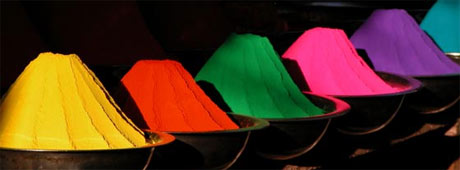
Pigment
The ingredients that comprise the color of the ink are referred to as pigment.
They come in the form of dyes, powders, liquid dispersions, or concentrated pastes. Some of these substances may be ingredients found in nature or they may be produced synthetically.
Vehicle
The vehicle is the substance in the ink mixture which carries the pigment and binds it to the printed surface.
It can be formulated from petroleum or vegetable oils, solvents, or water. The illustration below shows how the vehicle carries the pigment through the roller train of a press and transfers it to the paper.
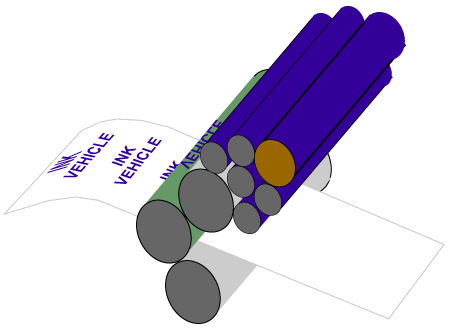
Additives and Modifiers
Additives and modifiers change the properties of the ink so that it can be used properly for different types of print processes and applications.
Additives and modifiers may include the following:
- Driers: speed up the ink drying process.
- Waxes: reduce the possibility of ink from the front of one sheet transferring to the back of another sheet (setoff).
- Antiskinning Agents: keep the ink from drying too rapidly and skinning over in the ink fountains of the printing press.
- Extenders: increase the coverage of the pigment in the ink.
- Distillates: improve the flow of ink.
Ink Characteristics
Body
The body refers to the consistency of the ink, which may vary from the beginning of a press run to the end of a press run because of external factors, such as prolonged exposure to the air and the increase in heat produced by the roller train of the press.
Tack
The tack refers to the stickiness of the ink. It is determined by the resistance of the ink film to “split”.
Splitting occurs when the ink from a printing plate is transferred to the printing blanket. transferring only only some of the ink. If it does not have the proper tack, the print quality will be poor due to insuffcient transfer of ink to the printed surface.
Viscosity
Viscosity is the degree that ink resists flow when it is under force, such as in the roller train of a printing press. If ink does not flow easily, it has a high viscosity, and if it flows easily, its viscosity is low.
As with body, the viscosity can change as it is used on a press, because of the friction and heat generated by the roller train. Viscosity is measured with an instrument called an inkometer.
Length
Length is the ability of ink to flow and is sometimes confused with viscosity (the degree to which ink resists flow under force).
It is necessary for the ink to move properly through the roller train of the press in order to achieve the best results. The friction and heat produced by the press may change the length of the ink.
Opacity
Opacity refers to the covering power of ink. Different pigments have different degrees of opacity because of the substances used to produce the pigments. Opacity is sometimes referred to as color strength.
Tinting Strength
Tinting strength is the ability of an ink color to produce a tint with the addition of white pigment and is also referred to as coloring power.
Permanency
The degree in which printed ink resists the fading power of light is known as permanency. Inks that have a greater proportion of their volume as pigment tend to fade more slowly.
The rate that an ink fades is known as the degree of light-fastness and is especially important when printed items, such as an outdoor billboard, will be exposed to a high level of light.
Standard Inks
Web Offset Non-Heatset Ink
The non-heatset variety of web offset printing ink is a common type of ink used on web presses for newspaper and business forms printing. Non-Heatset ink is printed on absorbent, uncoated paper stock.
Coated stocks should not be used with this type of ink because the paper will not completely absorb the ink, resulting in excess smudging and smearing.
Web Offset Heatset Ink
The heatset variety of web offset ink contains special varnishes that help the ink dry when heat is applied. Heatset presses are equipped with drier units for this purpose.
Due to the varnishes, the ink printed on the paper is highly flammable, so the drying units must be specially built and properly maintained to avoid potential hazards.
The main advantage of heatset ink is a printed product with a higher degree of quality.
Quickset Ink
Quickset ink contains a special varnish to speed the drying process. Unlike heatset ink, quickset ink does not require a heat source for proper drying and curing. The ink will not dry out on the press, but will dry quickly after it has been printed onto the substrate.
The are four basic processes that allows quickset ink to dry depending on the formulation: evaporation, absorption, oxidation, and polymerization.
Newer types of quickset ink have a greater proportion of antioxidants and higher boiling-point distillates, which evaporate more slowly, so the absorption process plays a greater role with the newer inks. All four processes share equally in the ink curing process with older ink types.
Uncoated paper stocks are best suited for quickset ink. This is because the low viscosity distillates and antioxidants are quickly absorbed by the substrate, which leaves the remaining pigment and vehicle to dry quickly on the surface.
Sheet-fed Ink
Sheet-fed ink is manufactured specifically for sheet-fed presses and usually has a higher tack than web offset inks. The reason for this is that most sheet-fed presses run at slower speeds than web presses and a higher tack is necessary to provide the necessary quality.
Rubber-base Ink
Ink formulated with a rubber base is a good choice when flexibility in the printing process is important. Rubber-base ink can be printed on coated and uncoated paper and it dries quickly. It is most often used on small sheet-fed presses.
Soybean-base Ink
Soybean-base ink is becoming a popular alternative to petroleum-base ink because of the ease in which it is used and because it is environmentally friendly. Soy-base ink prints and handles similar to petroleum-base ink, but it is much less toxic because of the soybean oil.
Soybean ink is biodegradable, meaning that it is eventually broken down and is much less hazardous to the environment.
Water-base Ink
Water-base ink has been around for a while, but it is still not as popular as other ink types. The usage of water-base ink may increase as environmental laws get tougher on the acceptable VOC (Volatile Organic Compounds) emissions generated from petroleum-base ink. Water-base ink emits no VOC’s. It is safe to work with and the print quality is comparable to other ink types.
Water-base ink is used mainly in flexography and gravure printing. It is a good choice for printers and customers who want their projects manufactured with nontoxic materials.
Laser Ink
Laser ink is specially formulated to withstand the extreme heat of the laser printer. If conventional ink is used for the preprinted portion of a document (such as an invoice or statement), the ink will melt in a laser printer because of the excessive heat it produces.
UV (Ultraviolet) Ink
Ultraviolet ink is formulated to cure and dry when exposed to a UV light source, unlike conventional ink, which dries through evaporation and absorption. UV ink can be applied to many types of substrates including paper, metal, vinyl, and glass.
Process Ink Colors
Process ink colors are used in Four Color Process Printing. Cyan, magenta, yellow, and black are the colors necessary for this process and are formulated differently for different types of printing processes.
High-Fidelity Ink Colors
High-fidelity ink colors are use in an advanced form of color printing, combining the standard four process colors of cyan, magenta, yellow, and black, with two more colors – usually orange and green. This allows for a greater color range, increased subtlety in the gradations of color, and additional vibrancy.
Specialty Inks
Non-porous Ink
Non-porous ink is used for printing on substrates, such as metal or plastic, that do not allow ink to be absorbed into the material. Because the printing surface of these materials is nonabsorbent, the ink dries solely through oxidation rather than absorption.
Metallic Ink
Metallic ink provides a distinctive look to a variety of print applications. The ink is produced by blending different types of metallic powders into the ink mixture, such as aluminum powder to create a silver appearance and bronze powder to create a gold appearance.
Metallic powder blended into the ink mixture cannot be ground as fine as other pigments because the metallic ink will lose its luster. The larger particles can create problems on the press, which is why some printers do a double hit (running the piece through the press a second time to apply another coat).
NOTE: Most printers require an upcharge for the use of metallic ink on an application because the ink is more expensive to produce and makes the print job more time consuming. Metallic ink tends to have a much shorter shelf life than standard ink.
Magnetic Ink
Magnetic ink is comprised of a petroleum-base ink blended with magnetic iron oxide particles. The magnetic iron oxide particles allow documents printed with this type of ink to be read and sorted by electronic scanning equipment.
Fluorescent Ink
Fluorescent is another type of ink that can provide a distinctive look for a variety of print applications. Fluorescent ink colors are most often printed on labels, posters, and signs that are used for alerting people to hazards or attracting their attention to advertising pieces.
Because of their tendency to fade, fluorescent inks have a short shelf life and should be kept out of direct sunlight. Another point to consider is that fluorescent ink is very transparent, so it may require a double hit in order to achieve the desired results.
Phosphorescent Ink
Applications printed with phosphorescent inks acquire a “glow in the dark” property after the phosphorescent area has been exposed to light. The length of time that an application will glow in the dark depends upon the ink ingredients and the length of time that the application is exposed to light.
In some cases, a 10-30 minute exposure to light can yield an afterglow of up to 12 hours. The ingredients of phosphorescent ink are nontoxic and are free of radioactive additives. It is very useful for road signs, sporting goods, exit signs, safety products, toys, and novelty items.
Pearlescent Ink
Pearlescent ink is a specialty ink that is used to add highlights and depth to the printed area of an application. It is able to provide an almost 3-dimensional effect to some applications.
Edible Ink
Edible ink is used on print applications that may come into contact with food or the ink may be part of the food product and therefore it must be made of totally nontoxic ingredients. These inks are strictly regulated by the government.
Scratch and Sniff Ink
Also known as a microencapsulated ink, scratch and sniff ink releases a fragrance when the microcapsules are scratched and broken. The scratch and sniff ink is commonly used in magazines for perfume advertisements.
Medical Device Ink
Ink used for printing on medical devices is made of nontoxic ingredients so that direct printing on noninvasive surgical and medical disposable items is possible.
Moisture Resistant Ink
Moisture resistant ink is most often used for different types of packaging or for applications that may be used outdoors.
Security Ink
There are a variety of inks that provide added security features to print applications. We will cover this particular ink type more indepth later on.
Desensitizing Ink
Desensitizing ink is a transparent ink that is applied to the face of CF (Coated Front) and/or CFB (Coated Front and Back) carbonless paper in order to deactivate the CF coating.
The use of desensitizing ink is important when an application requires that handwritten or imprinted data not be transferred through the various pages of a carbonless form in specific areas.
Electronic Ink

Electronic ink can be transformed from bright white to dark and then back to bright white again with a small electrical charge.
The ink consists of plastic microcapsules that contain both dark dye and white ink chips. The microcapsules are sandwiched between thin layers of flexible material, which substitutes for traditional paper.
When an electrical charge is applied, some of the white chips float to the top of some capsules to create a white surface and in other capsules, the white chips remain at the bottom allowing the dark fluid to remain visible.
After the initial electrical charge is applied, no further charge is required to hold the image in place. The content of the flexible page can be changed instantly and then be held on the page for as long as necessary.
Ink Related Printing Problems
Setoff
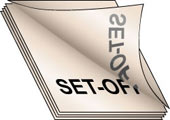
The transfer of ink from one sheet to the next sheet is known as setoff and is usually caused by too much ink being applied to the substrate and/or ink that is slow drying. The ink can be transferred from the front of one sheet to the back of the next and vice versa.
Slow Drying
One of the most common printing related problems is ink that dries too slowly. When ink dries slowly it may smudge and smear on the printed surface. The ink may also transfer from the front of one sheet to the back of the next one (setoff) and vice versa.
Both high humidity in the production area and high moisture content in the paper affect the ability of the ink to dry properly.
Poor Binding and Rub
This condition is sometimes confused with slow drying. With poor binding and rub, the ink is actually dry but the pigment can be easily rubbed off the surface. This can be caused by ink that does not have adequate bonding properties for the type of paper on which it is being printed.
Ink Adhesion
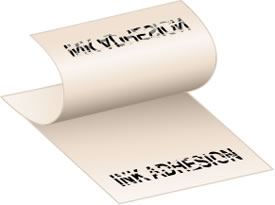
Ink adhesion is actually the result of setoff and slow drying ink, which in turn are usually the result of poorly adjusted press settings. The quantity of ink applied to the sheet or web can be so excessive that the ink acts as an adhesive, causing the sheets stick together.
Mottling
Mottling is a condition referring to an uneven appearance in the solid portions of a printed document, which can be caused by uneven absorption of ink, nonabsorbent papers, the wrong ink for the particular paper used, or faulty press adjustments.
Fill-in
Fill-in can cause a muddy look in printed screens and halftones and a speckled appearance in highlight areas. Areas of detail may disappear entirely. The causes of fill-in are contamination of the ink with paper fibers, lint, dirt and dust; substandard ink; the wrong choice of ink for the job; and/or improper press settings.
Misting
Misting occurs when an ink with too much length is used on high-speed presses. The ink actually turns into a fine mist and if the problem is significant, it may come in contact with the printed application. Misting can give the finished product a speckled appearance and create health hazards for press operators.
Piling
If a printed document has blotchy areas that are outlined by a non-printed line, it can be the result of piling. Piling is usually caused by faulty paper or ink. The paper may contain excessive paper dust or a poor coating.
The coating may be partially removed as it passes through the press, adhering to the printing blanket and plate, causing the blotchy appearance. The vehicle in the ink may not carry the pigment properly, which allows the pigment to pile on the plate and blanket of the press.
Color Matching
Occasionally, a color that is printed does not match the color that was intended. As with many printing related problems, improper press settings can be the cause, but other variables may also contribute to the problem. Some of the variables are listed below.
The color and texture of the paper changes the printed colors, so the choice of paper must considered early in the planning stage of the project.
Some of the ink colors can change slightly as they age, which may cause large color shifts, especially when older inks are mixed together to produce other colors.
Lighting conditions influence the appearance of color, which is why it is very important for the customer and printer to have a good proof to work from.
Trapping
Trapping refers to the alignment of colors on a printed document, such as a document printed with four-color process printing. Successful trapping depends a great deal on the tack of the ink. The first color printed on the sheet should have a higher tack than the second color printed, and so on.
Pantone Matching System®
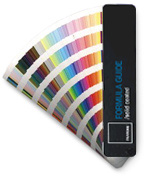
The Pantone Matching System® is the industry standard for selecting, matching, and mixing color. The Pantone Matching System® Color Guide is an indispensable tool for printers and designers. The guide contains swatches and formulas for all of the colors that can be attained using the Pantone System.
The Pantone Matching System® uses 11 basic colors to achieve over 1,000 color mixtures that are used by printers and art departments. The basic colors that are used are: yellow, warm red, rubine red, rhodamine red, purple, violet, reflex blue, process blue, green, black, and transparent white, which appears clear.
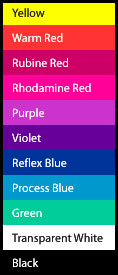
Each of the mixed colors are assigned a PMS number. The first number assigned for a mixed color is 100 and the numbering proceeds up from that point. The instructions for mixing the color are listed below the color swatch.
The mixing instructions include the number of parts of the specific base colors that are necessary to mix a particular color, as well as a percentage of the total volume for each of the colors that are required. For example, to mix the color, Pantone 198 (a red color), the mixing instructions are listed as follows:
- 6 parts (37.5%) Rubine Red
- 2 parts (12.5%) Yellow
- 8 parts (50%) Trans. White
By using the various ink formulas found in the swatch book, ink manufactures and printers can mix colors to exact specifications. Pantone also issues a digital color guide for electronic publishing which lists the color formulas in a format necessary for the colors to be displayed on a computer screen.
NOTE: We have stated this before but it deserves repeating. Pantone Color Guides should be replaced after one year because the printed colors in the swatch book will shift or fade and will no longer be a true representation of the actual colors.